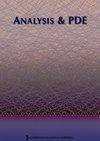相关系数场随机均匀化的定量估计
IF 1.9
1区 数学
Q1 MATHEMATICS
引用次数: 32
摘要
本文讨论具有平稳随机系数的散度形式的线性椭圆算子的均匀化问题,这些算子只有缓慢衰减的相关性。它从(扩展的)校正器的最优增长估计推导出均匀化误差的最优估计。根据试探法,在维度$d=2$处存在转换,并且对于相关性衰减指数$\beta=2$;我们从这两个临界性来源中获得了对数的正确幂。对于所考虑的系综,相关性的衰减是根据多尺度对数Sobolev不等式(LSI)进行尖锐编码的——如果相关性衰减是根据$\alpha$-混合条件进行编码的,则结果将失败。在随机介质建模中流行的其他集合中,这一类包括系数场,它是平稳高斯场的局部变换。校正器$\phi$的最优增长是从其梯度的空间平均值$F=\int g\cdot\nabla\phi$大小的边界得出的。这又是通过$F$的(确定性)灵敏度估计来实现的,也就是说,通过估计$F$w.~r.~t.~系数域$a$的函数导数$\frac{\partial F}{\fpartial a}$。以度量集中的形式吸引LSI产生$F$的随机估计。敏感性论点依赖于异构椭圆算子$-\nabla\cdot-a\nabla$的大规模Schauder理论。这种处理允许非对称$a$和线性弹性等系统。本文章由计算机程序翻译,如有差异,请以英文原文为准。
Quantitative estimates in stochastic homogenization for correlated coefficient fields
This paper is about the homogenization of linear elliptic operators in divergence form with stationary random coefficients that have only slowly decaying correlations. It deduces optimal estimates of the homogenization error from optimal growth estimates of the (extended) corrector. In line with the heuristics, there are transitions at dimension $d=2$, and for a correlation-decay exponent $\beta=2$; we capture the correct power of logarithms coming from these two sources of criticality.
The decay of correlations is sharply encoded in terms of a multiscale logarithmic Sobolev inequality (LSI) for the ensemble under consideration --- the results would fail if correlation decay were encoded in terms of an $\alpha$-mixing condition. Among other ensembles popular in modelling of random media, this class includes coefficient fields that are local transformations of stationary Gaussian fields.
The optimal growth of the corrector $\phi$ is derived from bounding the size of spatial averages $F=\int g\cdot\nabla\phi $ of its gradient. This in turn is done by a (deterministic) sensitivity estimate of $F$, that is, by estimating the functional derivative $\frac{\partial F}{\partial a}$ of $F$ w.~r.~t.~the coefficient field $a$. Appealing to the LSI in form of concentration of measure yields a stochastic estimate on $F$. The sensitivity argument relies on a large-scale Schauder theory for the heterogeneous elliptic operator $-\nabla\cdot a\nabla$. The treatment allows for non-symmetric $a$ and for systems like linear elasticity.
求助全文
通过发布文献求助,成功后即可免费获取论文全文。
去求助
来源期刊

Analysis & PDE
MATHEMATICS, APPLIED-MATHEMATICS
CiteScore
3.80
自引率
0.00%
发文量
38
审稿时长
6 months
期刊介绍:
APDE aims to be the leading specialized scholarly publication in mathematical analysis. The full editorial board votes on all articles, accounting for the journal’s exceptionally high standard and ensuring its broad profile.
 求助内容:
求助内容: 应助结果提醒方式:
应助结果提醒方式:


